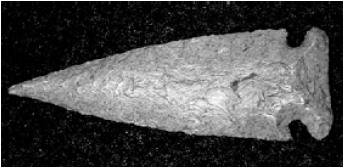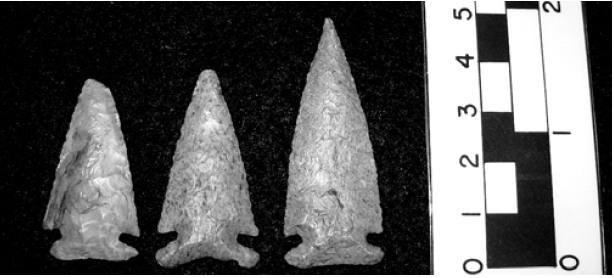
Initial Description: Spavinaw Creek are a
small to medium size side-notched dart point made on a triangular preform.
The blades are triangular in outline with edges that can be straight,
recurved or slightly convex. They are lenticular in cross section, often
have a needle- like tip and itís not unusual to see them with fine serrations. Delicate side notches are placed very low, near the base,
and are angled upwards. Basal edges are well-thinned and vary from straight, recurved, or

concave. When the base is deeply oncave, the low notches often give the
appearance of the point being auriculate or fish-tailed. They are finely
crafted with intricate flaking that ranges from random to parallel or even. Thermally
altered lithic stone seems to have been preferred, especially when Kay County
and Reeds
Spring chert was utilized. Spavinaw Creek points generally
attain lengths between 35mm-60mm and a width
of 17mm-20mm
Age/Culture: Concrete dates have yet to be established
but they are tentatively placed with terminal Hopewell and should date in
the A.D. 100 Ė A.D. 400
range, in eastern Oklahoma they are part of the Cooper
focus. They have been found in association with
late Woodland at the Shields site near Kansas City MO.
(Shippee, 1967; 33), Rice Shelter in Missouri (Bray,
1956; 131) the Lawrence site in Nowata Co, Oklahoma
(Baldwin, 1969; 87-90) and at site 3CW142, Pine
Mt. Lake in Crawford County, Arkansas (Hurdlebrink
1976).
Distribution: Spavinaw Creek are found
throughout the western edge of Ozarks plateau and the
central lowlands of Oklahoma and Kansas: Northeast
Oklahoma, northwest Arkansas, west Missouri and east
Kansas. The vast majority of Spavinaw Creek have been
found along the Arkansas River drainage and the Grand
Neosho waterway and its tributaries. As collectors become
more familiar with the type it will become easier
to establish a more comprehensive distribution range.
Commentary: Spavinaw Creek dart points are named
for the small perennial stream that begins in the Ozark foothills of northwestern
Arkansas and flows
into the Grand River in northeastern Oklahoma. There
are numerous sites along this waterway due to the potable
water, rock shelters, edible plants and abundant
wildlife.
Spavinaw Creek dart points were first recognized
for.examples found on two sites in Mayes County, Oklahoma.
Both sites contained numerous Hopewell artifacts
and late Woodland arrow points, but very little
else. A cache of Spavinaw Creek points found at one of the sites was instrumental
in showing variances within the type. The cache consisted of 7 points, made
of
Reeds Spring and Barren Fork chert. Basal configurations
for these points ranged from straight to concave
and the longest one has an extended tip.
Small, side-notched darts like these are prevalent
throughout much of the United States. At the northern
extent of their range Spavinaw Creek are often mistaken
for the high plains Pelican Lake point, and further
to the south they are often erroneously thought to be large
Scallorn, Edgewood or even Ensor. Bell (1984;148-
149) suggests that these similar points may represent
evidence for a late period adoption of the bow and arrow,
but their use as atlatl darts is much more likely.
There is a knife form that is found in association
with Spavinaw Creek dart points on occasion.
These corner to side notched knives are much larger and
can attain lengths of well over 3 inches. Size isnít the
only difference, the bases are almost always concave
and they are well-barbed.
Spavinaw Creek points are not rare; they can be seen commonly in collections
from the Southwestern Ozarks throughout the central lowlands of Oklahoma
and Kansas.
References:
Bray, Robert T.
1956 The Culture-Complexes and Sequence at the Rice Site (23SN200) Stone
County, Missouri. Preliminary Salvage Archaeology in the
Table Rock Reservoir Area, Missouri. The Missouri Archaeologist,
Volume 18, Numbers 1-2. The Missouri Archaeologist. 47-131
Bell, Robert E.
1984 Prehistory of Oklahoma. New World Archaeological Record. Academic Press,
Inc. New York
Hurdlebrink, Douglas, Judith C. Husted and Thomas Pilgrim
1976 Archaeological Sites Recorded and Tested in the Pine
Mountain Lake. Arkansas Archaeological Survey.
Research Report No. 7, Fayetteville,
Arkansas 72701
Shippee, J.M.
1967 Archaeological Remains in the Area of Kansas City:
The Woodland Period, Early, Middle, and Late. Missouri
Archaeological Society Research Series. No. 5.
Columbia, Missouri
Baldwin, Jane
1969 The Lawrence Site, Nw-6: A Non-Ceramic Site In Nowata
County, Oklahoma.
Bulletin of the Oklahoma Anthropological Society Volume
XVIII . Oklahoma City,
Oklahoma
At top: Spavinaw Creek dart points. These three were part
of a cache, and show just how varied the type can be. The longest
measures 2 inches in length.




